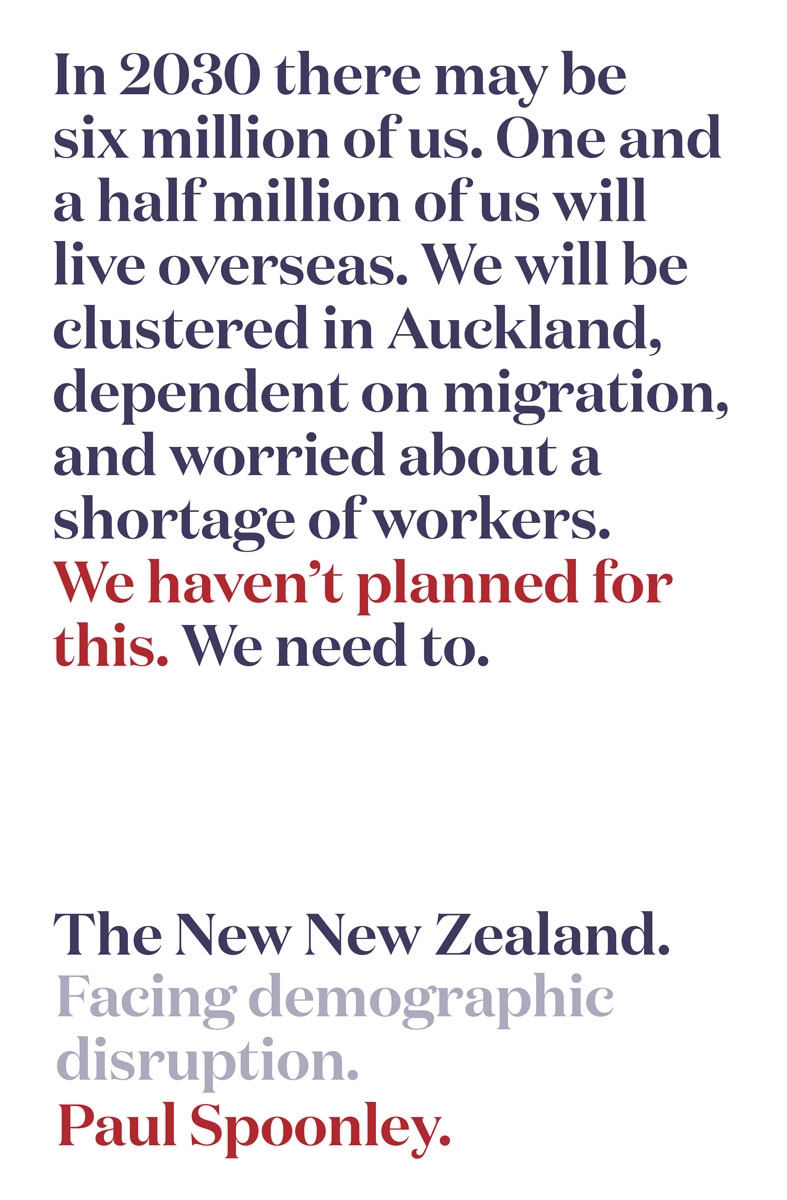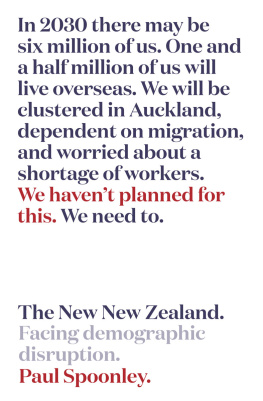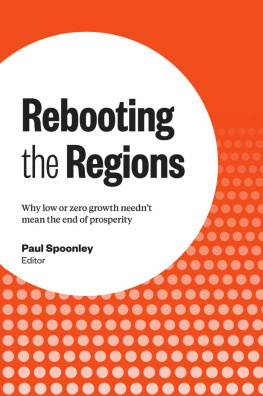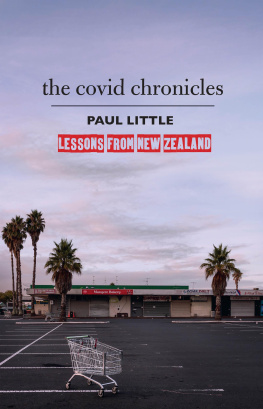Paul Spoonley - The New New Zealand: Facing demographic disruption
Here you can read online Paul Spoonley - The New New Zealand: Facing demographic disruption full text of the book (entire story) in english for free. Download pdf and epub, get meaning, cover and reviews about this ebook. year: 2020, publisher: Massey University Press, genre: Politics. Description of the work, (preface) as well as reviews are available. Best literature library LitArk.com created for fans of good reading and offers a wide selection of genres:
Romance novel
Science fiction
Adventure
Detective
Science
History
Home and family
Prose
Art
Politics
Computer
Non-fiction
Religion
Business
Children
Humor
Choose a favorite category and find really read worthwhile books. Enjoy immersion in the world of imagination, feel the emotions of the characters or learn something new for yourself, make an fascinating discovery.
- Book:The New New Zealand: Facing demographic disruption
- Author:
- Publisher:Massey University Press
- Genre:
- Year:2020
- Rating:4 / 5
- Favourites:Add to favourites
- Your mark:
- 80
- 1
- 2
- 3
- 4
- 5
The New New Zealand: Facing demographic disruption: summary, description and annotation
We offer to read an annotation, description, summary or preface (depends on what the author of the book "The New New Zealand: Facing demographic disruption" wrote himself). If you haven't found the necessary information about the book — write in the comments, we will try to find it.
Paul Spoonley: author's other books
Who wrote The New New Zealand: Facing demographic disruption? Find out the surname, the name of the author of the book and a list of all author's works by series.
The New New Zealand: Facing demographic disruption — read online for free the complete book (whole text) full work
Below is the text of the book, divided by pages. System saving the place of the last page read, allows you to conveniently read the book "The New New Zealand: Facing demographic disruption" online for free, without having to search again every time where you left off. Put a bookmark, and you can go to the page where you finished reading at any time.
Font size:
Interval:
Bookmark:


This book is dedicated to two John Spoonleys one is my father, born in 1913 and a migrant to New Zealand from Liverpool, who taught me the importance of understanding and tolerance and the other is my grandson, also John, who was born 106 years later.
A t moments in the history of communities, countries or the world, key elements of demography fertility, mortality and migration can coalesce to reshape societies, sometimes in dramatic ways. This might occur because of disease, disaster or conflict the influenza pandemic just after the First World War and the loss of life in major wars, for example. It might occur as a result of government policies that encourage more births: the election in 1935 of a Labour government and the extension of the welfare state, in which policies were built around a family wage and various family allowances, for example.
These shifts can be local and specific, but there also are moments when demographic change alters the very nature and structure of a community or nation, shifting the way in which they operate and determining policy options. One such transformation in our recent history is the arrival between 1945 and 1964 (sometimes given as 1965) of the baby boomers. The size of this very large cohort has had major consequences for the provision of services, from maternity care through to housing and education. Now, as New Zealand enters the 2020s, with its population reaching five million, the ageing of the baby boomers is a major consideration. It is creating an environment we have not encountered before, and its combining with other population shifts to become disruptive.
A very different Aotearoa New Zealand is emerging. Much of the demographic change is unprecedented in this young country, and in human history in general. On the one hand is the very large size of the cohort of those reaching age 65 and living longer. On the other is a fertility implosion, as family formation changes and births decline. The demographic structure is changing to such a degree that much of what we have put in place by way of policy or the provision of amenities and services is simply no longer appropriate or adequate.
When a society is both structurally and numerically ageing, immigration is one or a partial solution to the need for a workforce that will support an ageing population. But theres a paradox: at the very moment that immigration becomes even more important, countries such as the US, Japan and Hungary (or factions within them) are demonising immigrants and seeking to exclude them. New Zealand is not immune to anti-immigrant politics. When COVID-19 arrived in early 2020, many countries either closed or restricted access across their boarders as a measure to reduce the international transmission of the virus. This strategy was also used as an excuse by politicians in some countries to alter and reduce the rates of immigration.
L ike any other set of data generated by a pool of experts, the statistics and forecasts produced by demographers the people who study population change will invite either pessimism or optimism. There is no shortage of pessimists but I tend to be an optimist.
That optimism stems from the opportunity we have right now to analyse and debate, and from a willingness to change, even when those changes are extremely disruptive. In this book I have tried to limit statistical content, with varying success, and I have not engaged in some of the necessarily complex technical discussions about the generation or analysis of statistical material. What I have tried to emphasise, rather, is what I see as the more important trends and issues. If we do not engage with the implications of our current and future demography, using new (and often radically different) thinking, we gift future generations of New Zealanders a number of problems. We do them a major disservice.
After all, we have got to five million people far more quickly than anyone had predicted, at a rate the public was probably largely oblivious to. If those growth trends continue, how long until we are at six million? Is there a willingness to understand the evidence and to be open to what demographers are pointing out? And how proactive and forward-looking are our leaders likely to be? The new New Zealand is here, and we need to talk about it.
A degree of uncertainty remains, as the impacts of COVID-19 demonstrate, but we also have evidence and sophisticated modelling that allows us to anticipate with some accuracy what is likely to happen, especially over a two- to three-decade horizon. These projections are always constrained by the fact that demography is never an exact science.
The question is whether we stress the negative or the positive. As Newman notes, demography, like economics, is often the basis for doom-laden visions of the future. Thats why an important counterbalance is the acknowledgement that, while ageing and declining fertility are two very challenging factors, the current environment is also a product of major advances in health improvements, whose benefits we all enjoy. Nicholas Eberstadt, the Henry Wendt Chair in Political Economy at the American Enterprise Institute, wrote in 2010:
This global population explosion [a quadrupling of the earths population in the twentieth century, with a doubling of life expectancy] was, in reality, a health explosion: the entirety of the enormous increase in human population over the past several generations was due to dramatic declines in mortality and improvements in health conditions.
If this improvement in health and life expectancy characterised the twentieth century, then a fertility implosion is due to characterise the twenty-first.
I want to make three comments. First, the demographic changes experienced globally, and by high-income countries such as ours, are such that the past is not a good indicator of the future. The demographic transition is so profound that there is little in our historic responses to guide us in the future. For instance, in 2017 there were more people aged over 65 than there were aged under five; this has never previously occurred in high-income countries. Second, we have choices about how we approach these changes: we can stress their cataclysmic nature and worry about the consequences, or we can see potential and possibility in them.
And finally, we need to think creatively and boldly about what these changes mean and how we should, as national and local communities, respond. New Zealands current debates about immigration policy and ideal quotas are not informed by national population policy considerations or agreed levels of growth and size (and the spatial distribution of the population). Its the sort of thing we ought to have an informed national conversation about.
So, what are the major components of this demographic transition? In no particular order they are as follows.
In 2015, the World Economic Forum focused on Chinas demographic challenges, which the country was facing much earlier than anticipated. The discussion went on to note that of the 56 countries with a population of 20 million or more, nine are already experiencing population decline. Others will see population stagnation or decline in the future. These include: Germany, Japan, Ukraine, Russia, South Korea, Poland, Italy and Spain. Ukraine, for instance, is expected to drop by 22 per cent by 2050, and Japan by 15 per cent; it is anticipated that Germany will drop by 7.7 per cent in the same period, although this does not necessarily factor in immigration. And then there is China, which will shrink by 28 million people, or 2.5 per cent of its population, by 2050.
Next pageFont size:
Interval:
Bookmark:
Similar books «The New New Zealand: Facing demographic disruption»
Look at similar books to The New New Zealand: Facing demographic disruption. We have selected literature similar in name and meaning in the hope of providing readers with more options to find new, interesting, not yet read works.
Discussion, reviews of the book The New New Zealand: Facing demographic disruption and just readers' own opinions. Leave your comments, write what you think about the work, its meaning or the main characters. Specify what exactly you liked and what you didn't like, and why you think so.









